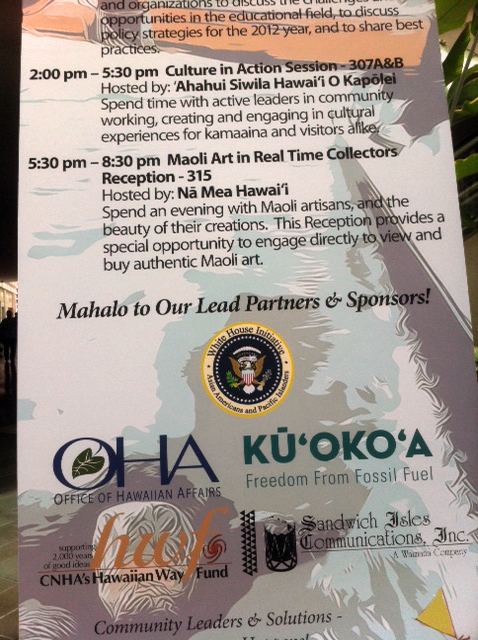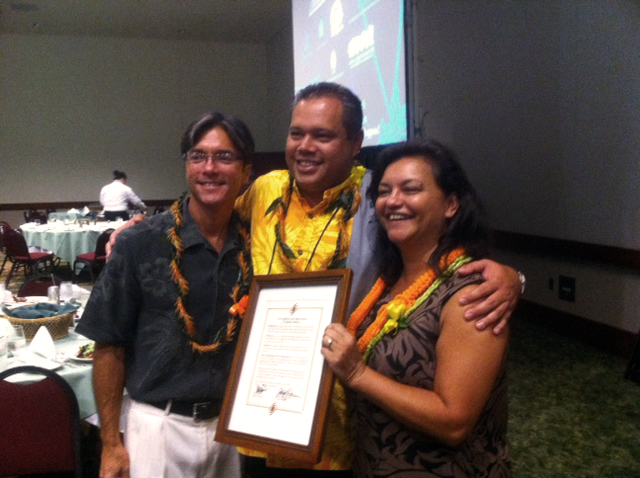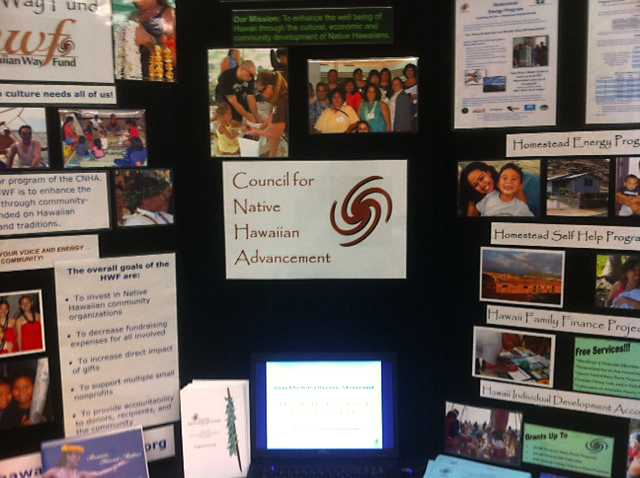Noe Kalipi also spoke at the Council of Native Hawaiians conference last week.
I knew Noe was on Senator Akaka’s staff for many years, and I thought she was a wonderful Hilo girl, very unassuming and nice.
But then I saw her in action, in Washington D.C., when we went up to see TJ Glauthier and Jim Woolsey. She is at home in Washington, and can jab elbows with the best. Who would have imagined that she was in the Airborne Judge Advocate Corp?
This Hilo girl was an Army lawyer and also jumped out of airplanes.
This is the speech she gave:
Why I Joined Kuokoa
I was born and raised in Hilo and spent 18 years in D.C., going to school, serving in the U.S. Army, and working on Capitol Hill for Senator Akaka. I moved back to Hilo in 2006 with my husband, Gaylen, who is from Molokai, to raise our two daughters, Hauoli and Kuuipo, in Hilo. It was important to us that they grow up in Hawaii, in our culture, exposed to the way we think, the way we live, and the way we do things in Hawaii.
I worked as the Government & Community Relations Director for First Wind. It was in THAT job where my eyes were opened to how dependent Hawaii is on fossil fuels and how DANGEROUS that is for our future, for our children’s future, for our moopuna’s future. Not blow up dangerous — dangerous because we have no control over the pricing for the one thing that we rely on for one of our most basic needs: energy.
I thought to myself, how could I not know this — I had been was working at the top levels of government in Washington DC!
It’s because I took things for granted. My thought process was – I need lights, turn on the switch; I need gas – go to the gas station – I need food – go to the store. I never thought about what made the lights go on or how the gas and food got to the store. I never thought about WHAT IF SOMETHING HAPPENS AND THE BARGES CAN’T COME TO HAWAII, and not just because we have a tsunami or hurricane, what about if we run out of oil?
Knowledge can be a blessing and it can be a burden. Once our eyes are opened to issues such as energy and food security then we have the kuleana to figure out how to address it.
The good news is that we live in Hawaii. We have the resources, the tools, to fix this situation. We have land and water to grow food, we have indigenous resources wind, solar, ocean, water, geothermal to generate electricity.
But most importantly, we have us, the indigenous peoples who have lived here for 2000 years, who have the moolelo, the history, of this place. We can look back to our history to figure out how we can go forward, embracing technology and finding solutions that are based and shaped by the knowledge of our incredibly scientific ancestors. As someone told me yesterday, we had the first light switch BEFORE THE WHITE HOUSE.
This means not only generating electricity but conserving and preserving our resources — turn off the lights, use energy efficient appliances, reuse, reduce, recycle.
What scares me is that this is not a new issue — people were talking about this when I was five years old — back in 1975 — how we had to get off of oil and use our resources.
I’m 41 years old. When are we going to stop talking and start doing?
So . . .when I learned about the Kuokoa plan from Richard Ha, our Chairman, I said YAY!! FINALLY — a collaborative way to do what we — as the box & rope, grassroots, rubbah slippah folks — whatever you want to call us — know what needs to be done. We can stop closing our eyes and pretending that someone else will take care of it. We can stop thinking that this is too hard, too complicated, too overwhelming.
As Richard said, get thousand reasons why no can, we need to focus on finding the ways that CAN. I thought, well, if HE, then I can, so WE GO
And that is why Kuokoa is at this convention. We need Native Hawaiians to lead this effort — WHY? Because this is OUR homeland.
This is a way to shift the paradigm — shift the way things are done. Base the action on culture, on history, on the knowledge that our ancestors left to us.
But Ramsay, Richard, and I cannot do it alone. Between the three of us, we know many of you in the audience and we hope that you will invite us to talk story with you so that we can explain what we are trying to do in more detail and to ask for you to join us in this effort. Kuokoa cannot succeed without you — because we need everyone working with us if we are going to make the changes that need to be done to secure Hawaii’s energy independence.
Kuokoa’s plan is simple — we build a clean tech industry in Hawaii and in that process we will:
– transform the electrical grid so that instead of running mainly on imported fossil fuel, it will use Hawaii’s indigenous resources: geothermal, wind, solar, water, ocean, biomass, etc. This stops our electricity prices from rising with oil prices.
– make electric vehicles a reality in Hawaii – this stops us from being slaves to the price of gas — it’s $5.49 a gallon on Molokai — what is going to happen when oil goes up further?
– to utilize excess electricity to create energy exports — hydrogen, for example, which can be exported as ammonia which sells globally and can be used for farming
In doing this, we make our universities and our schools the best schools in science, technology, research and development AND we make Hawaii the place to look to learn how to utilize indigenous resources in a culturally appropriate AND environmentally sensitive way.
In doing this, we create jobs and companies. We create opportunities for communities participate — and hopefully– to own the companies that are going to be created to make this plan successful. Let the Hawaiians hire the consultants to work for us instead of us always being the consultants for the mainland companies.
It’s not just science. It’s everything — farming, housing, education, economic development, cultural preservation, hawaiian language, health care –its everything we all are involved in because energy is a basic need — it either drives what we do or it prevents us from doing something. Lights or no lights. Gas or no gas.
All of our policy priorities that we just discussed ASSUMES that we have energy, ASSUMES that we have power. We need to make sure we address this basic need so that the policy goals that we are discussing this morning can truly help us to move forward the way we intend.
We are just three Hawaiians up here — our canoe is very big, and very heavy. We know we cannot paddle by ourselves. We hope you will be willing to pick up a paddle and join us and help us figure out how to get where we know we have to go.
Mahalo.



